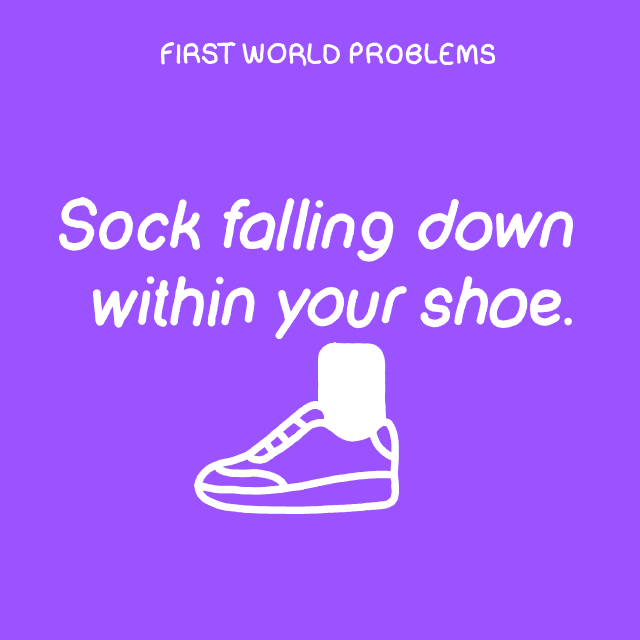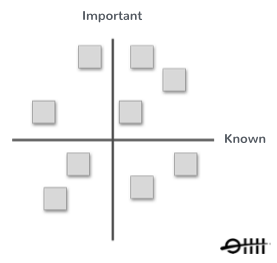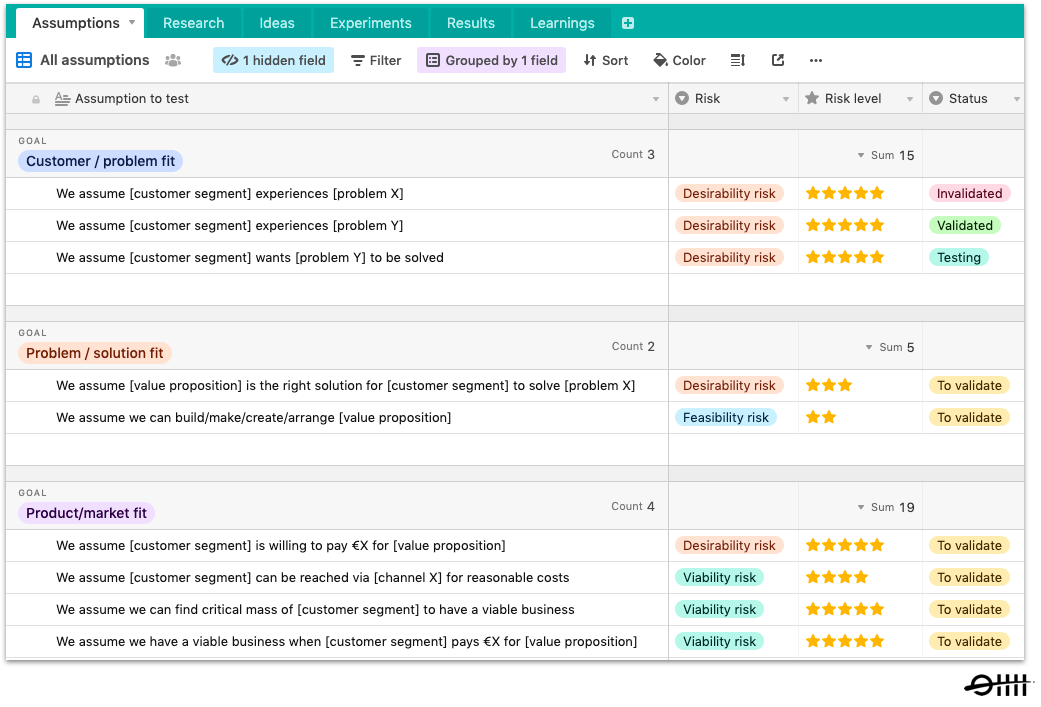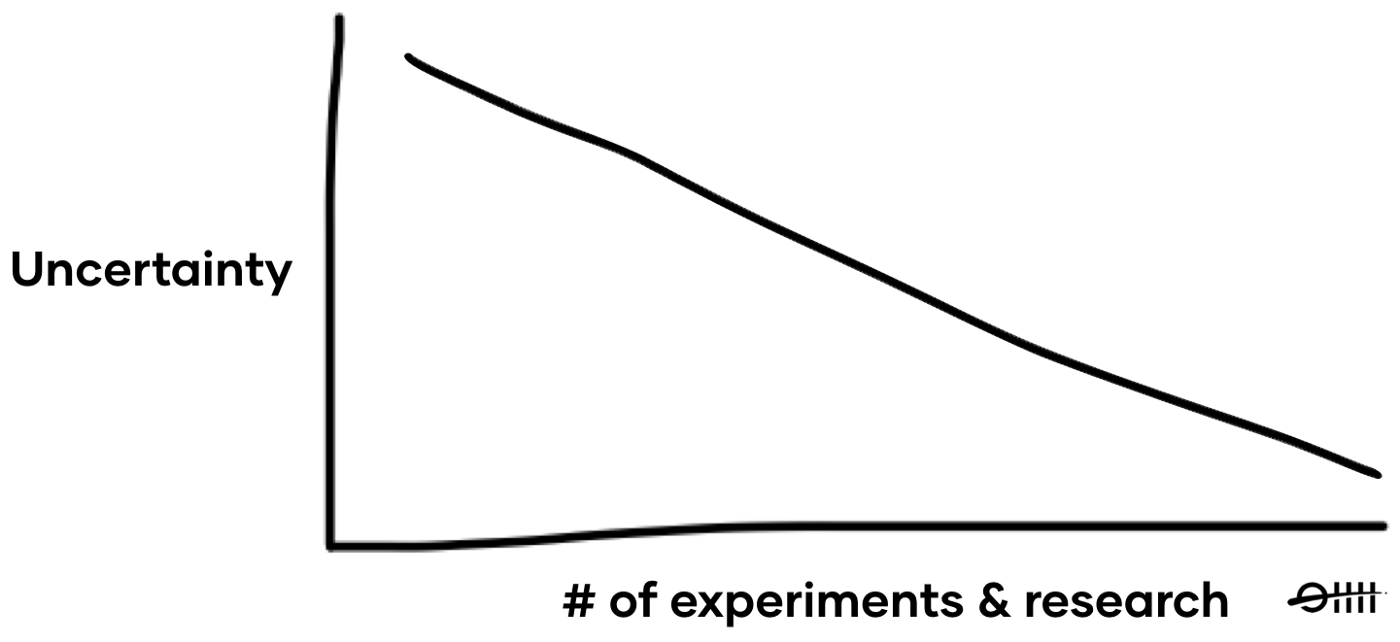How to reduce risk before going to market?
Ready, set, lau… Wait, are you really ready to launch your product into the market? I will provide you with a few useful tips, frameworks and a new template to discover if your business is ready to go to market.
What often happens is the following scenario:
Ambitious entrepreneurs create business plans behind their desks in their offices or houses. Usually, these plans are enormous documents with all kinds of ideas and strategies to conquer the market. However, these strategies are not based on anything but their own ideas & assumptions. What happens next is, they launch into the market (with their fingers-crossed) but do not manage to generate traction. They spend lots of euros on customer acquisition but these do not retain. Result: entrepreneur runs out of money…

Sounds familiar? This scenario is not necessary. The solution is to approach this process more lean & mean. You need to acknowledge that a business plan is one big assumption and you should first become more certain before launching your product into the market.
Read further to discover what three elements of your business model are the most essential to know before launching, based on our experience at Off The Record, a boutique growth bureau based in Amsterdam (notice the Canal houses in the illustration above ;-)). Besides that, I will show you a few useful frameworks to de-risk the whole business model in a systematic way. Finally, I added a special bonus––a template to make the frameworks actionable in order to start learning ASAP.
What are the three essential elements you should at least know before launching a product?
In my opinion, the following three questions are the most essential business questions. You should be able to state these on the back of a napkin before you start with building a company at all. The objective & truthful answers will give you more certainty when launching your product on the market.
1. Do you know what the biggest problem is of your customer segment?
A recent study that was conducted at over 100 startups showed the #1 reason for failure (43%) was no market needs. In other words: not solving a customer’s problem. We can’t stress this enough: before you launch, you must know who your customer is and what problem you’re solving. Even more important is that it should be something big enough to be worth solving. When that’s lacking, it will be very hard to create a market need.
Sure, the iPad was not invented because customers were experiencing “a big problem” without it— but a problem can also be frustration or pain while trying to get something done. For example, you try to relax on the couch but you are annoyed [pain] because of the small screen of your smartphone.
You might have an unfair advantage to experience the pain or problem yourself: that’s nice because then it will be easier to come up with a fitting solution. But still, this needs to be validated with others of your customer segment. Make sure you know the problem of your potential customer that’s worth solving. Talk to several people within your customer segment and know exactly what keeps them up at night.


2. Do you know what’s the value proposition and how to achieve this?
The solution for the customer’s problem is part of the value proposition — the statement of why a customer should choose to use or buy your product. This solution can take several forms, like a physical product (an umbrella against rain), software tooling (Intercom for customer support at scale), an app combined with a physical service (Deliveroo for eating restaurant–food at home), etc. One of the templates we often use to formulate the value proposition is Steve Blank’s:
“We help X do Y doing Z”.
See what he did there? It’s an effective way to formulate the customer segment (X), the problem (Y) and the solution (Z) in one sentence. An example: we help [people walking in the rain] to [not get wet] by [offering physical protection].
When you discovered what your solution should be, the next question is how you will achieve this. Will it be relatively easy to build the software product by just hiring a development team? Or will you be dependent on partners (e.g. manufacturers & logistics)? Another scenario is that the solution is only achievable with enough network effects (like having lots of users on social media platforms). Note that each scenario involves other risks.
3. Do you know via what channel your customer segment will find you?
Your acquisition channel should match your product and customer segment.
For example, it’s probably not efficient to advertise on a channel like TikTok when you want to reach the elderly, because they won’t be present on this channel. Another example is that it won’t be viable to sell your B2C game app (with €3 purchase costs) via a sales channel with expensive sales executives. Besides that, it won’t be scalable in the way a B2C app probably needs a certain volume to survive. Preferably, you already know before launching where your customer hangs out and whether this channel will allow you to acquire them in a viable way. In other words, a channel with healthy rates of customer acquisition costs and lifetime values.
What frameworks will help you to achieve this knowledge to launch?
As mentioned, the three questions stated above are, in our opinion, the most important to start with. Preferably answered as simple as on a napkin. To build further upon that, and to approach the business as a whole more systematically, I will show you our more elaborated approach at Off The Record.
1. We often use Strategyzer’s canvases for easy iterations.
The difference between an enormous business plan & using a canvas is the iteration– & learning velocity. The mindset of a plan is more refinement, planning, and execution while a canvas facilitates prototyping, testing & iteration. The Value Proposition Canvas gives more insight into the customer’s problem and your matching solution. The Business Model Canvas creates an easy overview of all your assumed strategies to conquer the market and how to create a viable business.

2. We plot the assumptions on David J. Bland’s matrix.
I cannot deny it: we’re a big fan of David J. Bland’s theories & matrix. We use it to discover what the riskiest parts of the business model are. In the beginning, everything stated on the business model canvas is an assumption. Therefore, the risk that a new business will fail is high. We need more certainty. To decide what we need to know first, we plot the assumptions based on risk. First, we ask ourselves what parts of the business canvas are the most important to know first. Secondly, we determine what parts of the business are already known facts (e.g. because of customers conversations, extensive research or having payment commitments already). The most important & most unknown assumptions (on the top right) are the ones to act upon first.

Often, the riskiest assumption is desirability by the potential customer. Building a product like a software tool is relatively easy — you only need to hire a smart dev team. But, what if the customer’s problem was actually not that big and the customer is not willing to pay a certain amount of money for the built product? That’s a risky scenario.
Sometimes there is no doubt that your potential value proposition is desired by the customer (e.g. discounted beers in bars — does not need an explanation). In that scenario, the highest risk of your business model is not whether the proposition is desired, but probably whether it is actually feasible to realize the value.
A third scenario is that both the product seems to be desired by the customer (they are willing to pay for the product) and it seems feasible to build the value proposition, however, the risk is in the pricing model. Will you make enough money to let your business survive? Building a viable business is hard and that raises the question if you actually should build the product. In this case, the first assumption to validate should be with respect to viability.
3. We start to validate the riskiest parts — using our experiment board.
We start to systematically test the assumptions. To make the previous step actionable and to maintain focus within this iterative learning process, we built this experiment board for this phase of a business. Use this Airtable template and start to reduce the risk of your own business. Below, you’ll find a few tips to use the template. (Btw, if you’re already past the validation phase, check out our template on growth, previously designed by Mike Wiendels).

Start with listing your assumed business statements. You can fill in the [fields] in the template with your own business content. As discussed above, the risk level per assumption is dependent on the business model and on how you would fill in your assumption matrix. To quantify this in a visual way, you can express the risk in stars next to the assumptions.
Focus first on the assumptions with the highest risk levels. Start validating these with small experiments, way before building and launching the real product. Eventually, the desired outcome is to have a full list of business assumptions with green “validated” statuses. Ready to launch!
Don’t launch when you’re still very uncertain
I hope it’s clear that the more certain you are about specific parts of your business model, the less risk and the more secure you will be that your product launch will be going through the roofs. My opinion? If you’re hoping for the best with your fingers-crossed when you’re pushing the “launch” button, you were not certain enough & the chances your business will fail will be high. Prevent this scenario by using the template above and become certain by doing experiments.

Of course, note that experiments can lead to both more certainty and uncertainty about your current business model. However, the most important thing is that you acknowledge the risks, and if evidence stipulates that the risk is too high, then iterate quickly. Make sure you don’t end up like the entrepreneur in the scenario described above. :)
